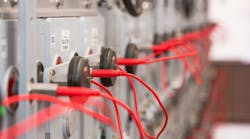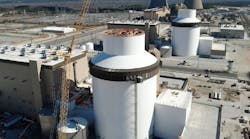The Energy Storage Association (ESA) was holding its annual event this year in Charlotte, North Carolina, U.S., and I was feeling the need to catch up with innovations in battery storage. I discovered the ESA is a great gathering place for technologists, startups, mature vendors, utilities and university types — a mosh pit of those who drive the energy storage future.
Black & Veatch hosted an awesome evening reception at the NASCAR Hall of Fame, and I had the good fortune of running into my friend Bill Muston. Bill is the technologist at Oncor who toured me about the Oncor microgrid located at their general services headquarters facility a bit outside of Dallas, Texas, U.S. Check out the article in the April 2016 issue of T&D World that provides details of this microgrid, including the installation of photovoltaic panels, Tesla storage batteries and a Capstone turbine.
On the first day of the ESA show, I went on a tour of Duke’s solar and energy storage test site at their Marshal Steam Station. I found utility-scale, residential and concentrated solar photovoltaic panels, whether of fixed-tilt, single-axis or dual-axis with a total nameplate rating of all systems of 1,100 kW. Duke recently installed a Kokam 750-kWh, 250-kW lithiumpolymer battery storage system equipped with S&C inverters and controls.
Dr. Sherif Abdelrazek, Duke’s distributed energy resources engineer, was on the premises to field questions. Sherif recently graduated from UNC Charlotte where he was working with Dr. Johan Enslin and Dr. Sukumar Kamalasadan to help Duke come up with a strategy to most effectively store and dispatch solar energy depending on customer load, weather, system constraints and energy costs. Sherif and Johan are now writing an article on the same, so suffice it to say a real treat is coming your way.
Look at these show numbers and you will get an idea of the burgeoning interest in energy storage systems. Attendee numbers went from 650 in 2014 to 1,000 in 2015 and now to 1,700 this year. This is crazy growth. Similarly, the exhibitors went from around 12 in 2010 to 66 in 2016. The technical program has greatly expanded as well. I caught several tracks that focused on utility storage installations. I found that each utility has different drivers and different energy storage requirements.
I also spent a fair amount of my time on the show floor. I had looked into flow batteries when they were first introduced and was eager to see recent progress has been made both in technology and in commercialization. Dave and I visited with Strategic Director flow battery manufacturer ViZn during the hospitality hour, meeting with Ron Van Dell, president and CEO, and Mike Grunow, vice president of marketing. ViZn’s flow battery can perform both high-power and long-duration applications to enable multiple revenue streams, and with zero cell replacements over a 20-year operating life for utility and commercial and industrial customers.
The concept behind the ViZn flow battery is to plate zinc on a steel bar, and when discharging, to reverse the flow, taking the zinc back into the solution. With the active ingredients of iron and zinc, this technology can easily scale as the chemical components are globally abundant and inexpensive.
Ron mentioned that the batteries can be shipped dry and the electrolyte added in the field. The ViZn system is designed to scale by stacking flow battery units until the desired power and the desired energy is obtained.
When it comes to storing bulk kilowatt-hours, I found two companies touting liquid air energy storage. Yes, I said liquid air. Now don’t go jumping to conclusions, because this idea is not as far out as it might first seem.
I listened in on a presentation by Jeremy Dockter with Expansion Energy and chatted with him afterward. According to Jeremy, Expansion Energy’s VPS Cycle energy storage technology is cost-effective (in terms of dollars per kilowatt and dollars per kilowatt-hours) and scalable from 5 MW to more than 500 MW, with discharge capacity from 4 hours to 10 hours per day. The unit stores power via liquefied air and releases that power through a next-generation combined-cycle system that uses no water. What most caught my attention is that Expansion Energy is focusing on using 100% off-the-shelf equipment. Components include multistage air compressors, chillers, cryogenic refrigeration and cryogenic pumps, along with requisite heat exchangers.
Highview Energy Storage is also active in liquid air storage. I chatted with Highview’s business development manager, David Kaye, who shared that they are working with renewable energy and waste management company Viridor to install a UK government- funded 5-MW energy storage demonstration project.
We are starting to gather materials for a storage supplement to run in 2017. Let us know what you have working, and we will be glad to share your progress with our audience.


